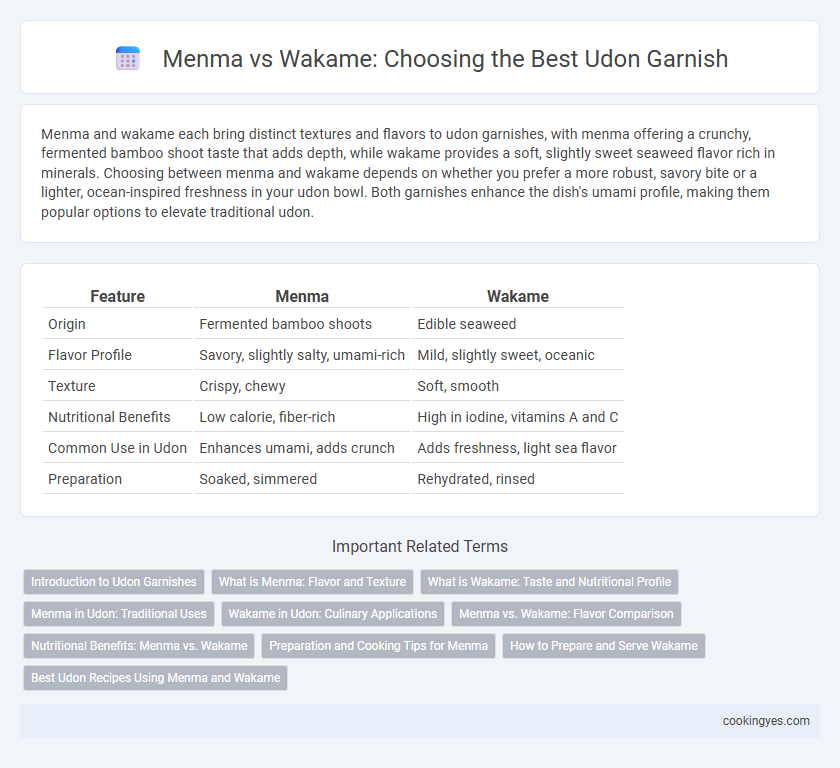Menma and wakame each bring distinct textures and flavors to udon garnishes, with menma offering a crunchy, fermented bamboo shoot taste that adds depth, while wakame provides a soft, slightly sweet seaweed flavor rich in minerals. Choosing between menma and wakame depends on whether you prefer a more robust, savory bite or a lighter, ocean-inspired freshness in your udon bowl. Both garnishes enhance the dish's umami profile, making them popular options to elevate traditional udon.
Table of Comparison
| Feature | Menma | Wakame |
|---|---|---|
| Origin | Fermented bamboo shoots | Edible seaweed |
| Flavor Profile | Savory, slightly salty, umami-rich | Mild, slightly sweet, oceanic |
| Texture | Crispy, chewy | Soft, smooth |
| Nutritional Benefits | Low calorie, fiber-rich | High in iodine, vitamins A and C |
| Common Use in Udon | Enhances umami, adds crunch | Adds freshness, light sea flavor |
| Preparation | Soaked, simmered | Rehydrated, rinsed |
Introduction to Udon Garnishes
Menma and wakame serve as popular garnishes that enhance udon's flavor and texture, each offering distinct culinary benefits. Menma, which is fermented bamboo shoots, adds a crunchy texture and umami-rich taste, complementing the soft, chewy noodles of udon. Wakame, a type of seaweed, provides a delicate, slightly sweet flavor along with a tender consistency and is rich in iodine and minerals, making it a nutritious topping.
What is Menma: Flavor and Texture
Menma, a fermented bamboo shoot, offers a unique combination of a savory, slightly tangy flavor and a firm, crunchy texture that enhances udon dishes. Its umami-rich taste contrasts with the mild, briny flavor of wakame seaweed, providing a deeper complexity to the broth. Menma's crispness adds a delightful bite, making it a popular garnish choice for both hot and cold udon bowls.
What is Wakame: Taste and Nutritional Profile
Wakame is a type of edible seaweed commonly used as a garnish for udon, known for its subtly sweet and briny flavor that complements the mild taste of the noodles. Nutritionally, wakame is rich in essential minerals such as iodine, calcium, and magnesium, and provides a significant source of dietary fiber and antioxidants that support digestion and overall health. Its low calorie content and high nutrient density make wakame a preferred garnish for health-conscious udon enthusiasts seeking both flavor and nutritional benefits.
Menma in Udon: Traditional Uses
Menma, fermented bamboo shoots, add a distinct umami flavor and crunchy texture to udon, enhancing the overall eating experience with traditional Japanese authenticity. Unlike wakame seaweed, which provides a smooth, slightly salty taste and a soft texture, menma is prized for its savory depth and subtle sweetness that complements the chewy udon noodles. Menma's inclusion in udon is rooted in regional culinary practices, often favored in Kansai-style udon dishes for its bold contrast to the light broth.
Wakame in Udon: Culinary Applications
Wakame enhances udon dishes with its delicate texture and subtle umami flavor, complementing the chewy noodles and broth. Its nutritional benefits, rich in iodine, calcium, and vitamins, make it a popular choice among health-conscious consumers. Compared to Menma, Wakame offers a lighter, seaweed-based garnish that integrates seamlessly into both hot and cold udon preparations, adding a refreshing taste and visual appeal.
Menma vs. Wakame: Flavor Comparison
Menma offers a savory, slightly sweet, and umami-rich flavor with a crunchy texture that enhances udon dishes. Wakame provides a subtle, briny taste with a tender, silky texture that complements the broth's complexity. Choosing between Menma and Wakame depends on whether a more robust, textured bite or a delicate, oceanic note is preferred to elevate the udon experience.
Nutritional Benefits: Menma vs. Wakame
Menma, fermented bamboo shoots, are rich in dietary fiber, potassium, and beneficial enzymes aiding digestion, while Wakame, a type of seaweed, offers higher levels of iodine, calcium, and vitamins A and C essential for thyroid health and immune support. Menma provides a lower-calorie option with prebiotic properties that promote gut health, whereas Wakame supplies omega-3 fatty acids and antioxidants that help reduce inflammation. Choosing between Menma and Wakame as udon garnishes depends on whether you prioritize fiber and digestive benefits or mineral richness and immune-enhancing nutrients.
Preparation and Cooking Tips for Menma
Menma, fermented bamboo shoots, require thorough rinsing and soaking to reduce their salty, pickled flavor before adding to udon, ensuring a balanced taste that complements the broth. Lightly sauteing menma in sesame oil with garlic and soy sauce enhances its umami and provides a crunchy texture contrasting well with soft noodles. Unlike wakame, which is usually rehydrated briefly, menma's preparation demands more care to avoid overpowering the delicate dashi used in udon dishes.
How to Prepare and Serve Wakame
Wakame is a seaweed commonly used as a garnish for udon, prized for its mild flavor and soft texture that complements the thick noodles. To prepare wakame for udon, soak dried wakame in cold water for 5-10 minutes until it expands and rehydrates, then drain and chop it into bite-sized pieces. Serve wakame by adding it directly to the udon broth just before serving, allowing it to warm without losing its texture, enhancing the dish with a subtle oceanic taste and nutritional benefits like iodine and calcium.
Best Udon Recipes Using Menma and Wakame
Menma and wakame both elevate udon dishes through their unique textures and flavors, with menma offering a crunchy, fermented bamboo shoot contrast and wakame providing a tender, umami-rich seaweed note. The best udon recipes featuring menma include spicy miso udon and shoyu-based broths, where menma enhances depth and complexity. Wakame shines in lighter, dashi-based udon soups and cold udon salads, complementing the subtle broth with its smooth, mineral-rich taste.
Menma vs Wakame for udon garnishes Infographic

 cookingyes.com
cookingyes.com